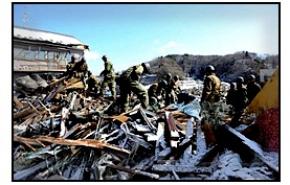ID :
169688
Mon, 03/21/2011 - 12:46
Auther :
Shortlink :
http://m.oananews.org//node/169688
The shortlink copeid
World Bank expects the rehabilitation of Japan to cost initially 12 billion US dollars

BANGKOK, March 21 (TNA) - Vikram Nehru, World Bank’s chief economist for the East Asia and Pacific, said the World Bank, in its East Asia and Pacific Update in March 2011, estimated damages of the disaster in Japan at 112-235 billion US dollars which accounted for 2.5-4% of the gross domestic product of the country. The damage is greater than that resulting from the previous earthquake in Japan’s Kobe city in 1995 when the amount was estimated at 100 billion US dollars.
Compensation from insurers is expected at 14-33 billion US dollars and rehabilitation will cost the Japanese government 12 billion US dollars in the present fiscal year and more in the following fiscal year. The World Bank believes that the latest disaster will negatively affect the growth of the real GDP until mid this year and the Japanese economy should resume its expansion in the third quarter of this year due to accelerated investments for the national rehabilitation. The World Bank expects the slowdown of the Japanese economy will have only limited and short-lived impacts on economies in the region.
Regarding the impacts of the latest earthquake in Japan on international trade, Mr Nehru said that if the GDP of Japan declines by 0.25-0.5%, exports in the region will drop by 0.75-1.5%. Damages to automotive and electronic industries are the important factors that need to be monitored because Japan is the main producer of auto parts in East Asia. In Thailand, the stocks of auto parts of automobile exporters will remain only until the end of April and some plants in Japan start to suffer from auto part shortages for the time being.
The World Bank predicts that the East Asian economy will grow by 8% this year. The growth will be slower than its 9.6% increment last year due to inflation that is the urgent problem of countries in East Asia. (TNA)
Compensation from insurers is expected at 14-33 billion US dollars and rehabilitation will cost the Japanese government 12 billion US dollars in the present fiscal year and more in the following fiscal year. The World Bank believes that the latest disaster will negatively affect the growth of the real GDP until mid this year and the Japanese economy should resume its expansion in the third quarter of this year due to accelerated investments for the national rehabilitation. The World Bank expects the slowdown of the Japanese economy will have only limited and short-lived impacts on economies in the region.
Regarding the impacts of the latest earthquake in Japan on international trade, Mr Nehru said that if the GDP of Japan declines by 0.25-0.5%, exports in the region will drop by 0.75-1.5%. Damages to automotive and electronic industries are the important factors that need to be monitored because Japan is the main producer of auto parts in East Asia. In Thailand, the stocks of auto parts of automobile exporters will remain only until the end of April and some plants in Japan start to suffer from auto part shortages for the time being.
The World Bank predicts that the East Asian economy will grow by 8% this year. The growth will be slower than its 9.6% increment last year due to inflation that is the urgent problem of countries in East Asia. (TNA)





